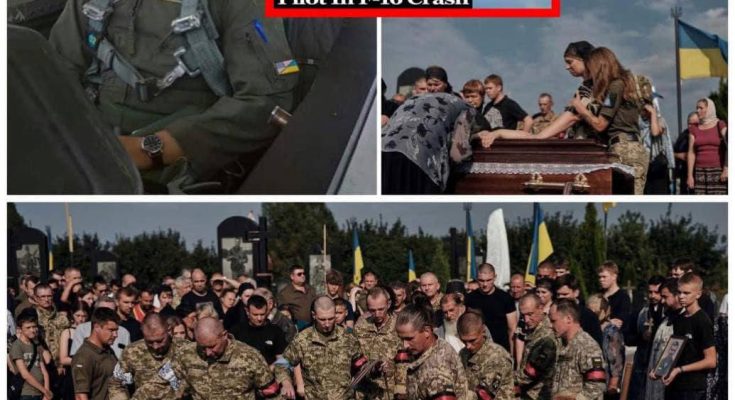The war in Ukraine took another devastating turn as a US-made F-16 fighter jet was destroyed in a crash following a massive Russian missile attack across the country. The incident underscores the growing intensity of aerial combat and the increasing role of Western-supplied military equipment in Ukraine’s defense against Russia’s ongoing invasion.
The Attack and the F-16’s Fate
According to Ukrainian military officials, the F-16 was engaged in a defensive mission when it went down. Russia launched a large-scale missile barrage targeting key infrastructure and military installations across Ukraine, prompting Ukrainian air defenses and fighter jets to respond.
Details surrounding the F-16’s destruction remain unclear, but preliminary reports suggest the aircraft may have been downed while attempting to intercept incoming missiles. Some sources indicate that Russian air defenses or advanced anti-aircraft systems may have played a role in the crash. Others speculate that the jet could have suffered a mechanical failure or pilot error amid the high-stakes battle in the skies.
Significance of the F-16 in Ukraine
The loss of an F-16 is a significant moment in the war, as these advanced fighter jets represent a major shift in Ukraine’s air capabilities. For months, Ukrainian officials had requested Western nations, particularly the United States and European allies, to supply F-16s to counter Russia’s superior air power.
F-16s, widely regarded as one of the most versatile and combat-proven fighter jets in the world, provide Ukraine with improved air-to-air and air-to-ground combat capabilities. These jets are capable of intercepting Russian aircraft, targeting ground forces, and defending Ukrainian skies against missile and drone attacks.
Despite their advantages, Ukrainian pilots face challenges operating the F-16, as training programs are still ongoing, and the aircraft requires extensive maintenance and logistical support. The destruction of this jet raises concerns about how Ukraine will sustain its fleet amid continued Russian aggression.

Russia’s Ongoing Missile Barrages
The missile attack that led to the F-16’s crash was part of a larger pattern of Russian bombardments targeting Ukraine’s cities, energy infrastructure, and military assets. In recent months, Russia has intensified its strikes, using a mix of long-range cruise missiles, ballistic missiles, and kamikaze drones to weaken Ukraine’s defenses.
Ukraine’s air defense systems, reinforced with Western-supplied Patriot and NASAMS missile systems, have intercepted many incoming threats. However, the scale and frequency of Russian attacks continue to strain Ukrainian resources, making it difficult to prevent every strike.
Military analysts suggest that Russia’s strategy is aimed at overwhelming Ukraine’s air defenses while testing the effectiveness of newly introduced Western fighter jets. The destruction of an F-16 could serve as propaganda for Moscow, reinforcing its narrative that Western military aid will not alter the outcome of the war.
What This Means for the War….
The downing of an F-16 is a blow to Ukraine’s air force, but it does not diminish the country’s determination to strengthen its aerial capabilities. Kyiv remains committed to integrating advanced Western fighter jets into its military strategy, and its allies are likely to continue supplying Ukraine with additional aircraft.
The incident, however, raises concerns about the vulnerability of Western-supplied military hardware in the conflict. If Russian forces were responsible for shooting down the F-16, it could indicate a growing ability to counter advanced fighter jets, potentially affecting future air operations.

Furthermore, the attack highlights the urgent need for continued support from NATO allies. Ukraine has been pushing for more advanced air defense systems and fighter jets to counter Russia’s aerial superiority. The destruction of an F-16 may prompt further discussions among Western nations about accelerating military aid and training programs.
The incident has drawn reactions from both Ukrainian and Western officials. Ukrainian President Volodymyr Zelensky condemned Russia’s missile attacks, emphasizing that they deliberately target both civilian and military infrastructure. He reiterated Ukraine’s need for more advanced weapons, including additional fighter jets and missile defense systems.
In Washington, Pentagon officials acknowledged the loss of the F-16 but reaffirmed their commitment to supporting Ukraine. “The provision of F-16s was never about a single aircraft—it’s about strengthening Ukraine’s long-term defense capabilities,” a U.S. defense spokesperson said.
Meanwhile, Russian state media has celebrated the destruction of the jet, portraying it as evidence that Western-supplied weapons will not change the battlefield dynamics. Moscow has warned NATO countries that continued military aid to Ukraine only escalates the conflict and increases the risk of direct confrontation.
As Ukraine continues to integrate F-16s into its air force, the war’s aerial dimension is expected to intensify. The loss of a single jet is a setback, but Ukraine remains focused on improving its operational effectiveness with Western-supplied aircraft.
Moving forward, key questions remain:
• Will Ukraine’s allies increase military aid to compensate for the loss of the jet?
• Can Ukrainian pilots and defense systems adapt quickly enough to counter Russian air and missile threats?
• Will Russia escalate its efforts to target Western fighter jets in future attacks?
One thing is clear: the skies over Ukraine remain a fierce battleground, and as more advanced aircraft enter the conflict, the stakes for both sides continue to rise.



